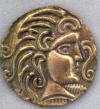Earliest Evidence of Humans Changing Ecosystems with Fire

Mastery of fire has given humans dominance over the natural world. A Yale-led study provides the earliest evidence to date of ancient humans significantly altering entire ecosystems with flames.
The study, published on May 5 in the journal Science Advances, combines archaeological evidence — dense clusters of stone artifacts dating as far back as 92,000 years ago — with paleoenvironmental data on the northern shores of Lake Malawi in eastern Africa to document that early humans were ecosystem engineers. They used fire in a way that prevented regrowth of the region’s forests, creating a sprawling bushland that exists today.
Lake Malawi in Africa, photographed by astronauts aboard the Space Shuttle.
Credit: NASA / Wikimedia Commons
Yale paleoanthropologist Jessica Thompson describes the earliest evidence of humans altering their ecosystem with fire in this video.
Thompson authored the study with 27 colleagues from institutions in the United States, Africa, Europe, Asia, and Australia. Thompson led the archaeological work in collaboration with the Malawi Department of Museums and Monuments; David Wright of the University of Oslo, who led efforts to date the study’s archaeological sites; and Sarah Ivory of Penn State, who led the paleoenvironmental analyses.
The artifacts examined by the researchers are of the type produced across Africa in the Middle Stone Age, a period dating back at least 315,000 years. The earliest modern humans made their appearance during this period, with the African archaeological record showing significant advances in cognitive and social complexity.
Lake Malawi’s water levels have fluctuated drastically over the ages. During the lake’s driest periods, the last of which ended about 85,000 years ago, it diminished into two small, saline bodies of water. The lake recovered from these arid stretches and its levels have remained high ever since, according to the study.
The archaeological data were collected from more than 100 pits excavated across hundreds of kilometers of the alluvial fan that developed during this time of steady lake levels. The paleoenvironmental data are based on counts of pollen and charcoal that settled to the floor of the lakebed and were later recovered in a long sediment core drilled from a modified barge.
“The pollen that we see in this most recent period of stable climate is very different than before,” she said. “Specifically, trees that indicate dense, structurally complex forest canopies are no longer common and are replaced by pollen from plants that deal well with frequent fire and disturbance.”
The increase in archaeological sites after the last arid period, paired with the spike in charcoal and absence of forest, suggests that people were manipulating the ecosystem with fire, the researchers conclude. The scale of their environmental impact over the long term is something typically associated with farmers and herders, rather than hunter-gatherers. This suggests early ecological manipulation on par with modern people and may also explain why the archaeological record formed.
The burning paired with climate-driven changes created the conditions that allowed for preservation of millions of artifacts in the region, the researchers explained. “Dirt rolls downhill unless there is something to stop it,” Wright said. “Take the trees away, and when it rains, there is a lot of dirt moving downhill in this environment.”
Previous transitions from dry to wet conditions in the region didn’t yield a similar alluvial fan and were not preceded by the same charcoal spike, the researchers noted.
It’s not clear why people were burning the landscape, Thompson said. It’s possible that they were experimenting with controlled burns to produce mosaic habitats conducive to hunting and gathering, a behavior documented among hunter-gatherers. It could be that their fires burned out of control, or that there were simply a lot of people burning fuel in their environment that provided for warmth, cooking, or socialization, she explained.
“One way or another, it’s caused by human activity,” she said. “It shows early people, over a long period of time, took control over their environment rather than being controlled by it. They changed entire landscapes, and for better or for worse that relationship with our environments continues today.”
###
This work was funded by the Australian Research Council, the National Geographic-Waitt Foundation, the Wenner-Gren Foundation, the University of Queensland Archaeological Field School, the Korean Research Foundation Global Research Network, Deutsche Forschungsgemeinschaft, Emory University, and the Belmont Forum.
Bess Connolly
Yale University
Source: http://www.ineffableisland.com/2021/05/earliest-evidence-of-humans-changing.html
Anyone can join.
Anyone can contribute.
Anyone can become informed about their world.
"United We Stand" Click Here To Create Your Personal Citizen Journalist Account Today, Be Sure To Invite Your Friends.
Before It’s News® is a community of individuals who report on what’s going on around them, from all around the world. Anyone can join. Anyone can contribute. Anyone can become informed about their world. "United We Stand" Click Here To Create Your Personal Citizen Journalist Account Today, Be Sure To Invite Your Friends.
LION'S MANE PRODUCT
Try Our Lion’s Mane WHOLE MIND Nootropic Blend 60 Capsules
Mushrooms are having a moment. One fabulous fungus in particular, lion’s mane, may help improve memory, depression and anxiety symptoms. They are also an excellent source of nutrients that show promise as a therapy for dementia, and other neurodegenerative diseases. If you’re living with anxiety or depression, you may be curious about all the therapy options out there — including the natural ones.Our Lion’s Mane WHOLE MIND Nootropic Blend has been formulated to utilize the potency of Lion’s mane but also include the benefits of four other Highly Beneficial Mushrooms. Synergistically, they work together to Build your health through improving cognitive function and immunity regardless of your age. Our Nootropic not only improves your Cognitive Function and Activates your Immune System, but it benefits growth of Essential Gut Flora, further enhancing your Vitality.
Our Formula includes: Lion’s Mane Mushrooms which Increase Brain Power through nerve growth, lessen anxiety, reduce depression, and improve concentration. Its an excellent adaptogen, promotes sleep and improves immunity. Shiitake Mushrooms which Fight cancer cells and infectious disease, boost the immune system, promotes brain function, and serves as a source of B vitamins. Maitake Mushrooms which regulate blood sugar levels of diabetics, reduce hypertension and boosts the immune system. Reishi Mushrooms which Fight inflammation, liver disease, fatigue, tumor growth and cancer. They Improve skin disorders and soothes digestive problems, stomach ulcers and leaky gut syndrome. Chaga Mushrooms which have anti-aging effects, boost immune function, improve stamina and athletic performance, even act as a natural aphrodisiac, fighting diabetes and improving liver function. Try Our Lion’s Mane WHOLE MIND Nootropic Blend 60 Capsules Today. Be 100% Satisfied or Receive a Full Money Back Guarantee. Order Yours Today by Following This Link.








And the UNINTELLIGENT, post more CRAP AND BULLSHIT!…….the SHIT most humans FLUSH every morning is more interesting than the GARBAGE being posted by ALTON here. At least the SHIT you had in the MORNING was REAL!….